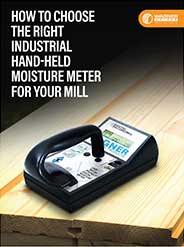Common Types of Wood for Woodworking
Overwhelmed by all the options? Wondering what kind of wood will best suit your project?
Here, we’ll look at 7 of the most common types used by woodworkers: oak, maple, cherry, walnut, mahogany, pine, and cedar.
And those are just several of the thousands of options! But what you’ll find is that not every option is suitable for every project. Different types of wood have qualities that make them work well for certain projects, such as flooring, cabinets, and furniture.
To help you in your project planning, we’ll cover:
We’ll first address a common misconception about hardwoods and softwoods. You’ll learn about the pros and cons of each for woodworking.
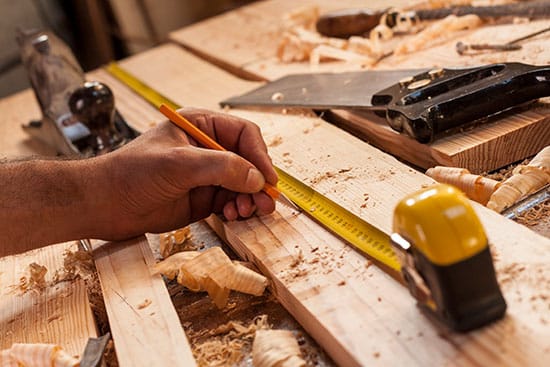
Softwoods are sometimes preferred because they are easy to work with, and take paint and finish well, but they are not as strong as most hardwoods.
Hardwood Vs. Softwood
The difference between hardwoods and softwoods is not, as many think, the hardness or softness of the wood. Hardwoods are angiosperms—deciduous trees that have leaves and produce seeds within the fruit. Softwood trees, on the other hand, are gymnosperms—coniferous trees that have needles.
One key difference between the two is their nutrient transport system. Hardwood trees have large vessels, called pores, that transport nutrients. For this reason, they’re called porous wood.1
But softwoods have less visible fibers called medullary rays and tracheids, earning them the name non-porous wood.2
In general, hardwoods tend to be stronger and more durable than softwoods, though this is not always the case.
Here’s what woodworker Ellis Walentine said about it in Woodworker’s Journal:
“The glib answer is that hard wood is hard and soft wood is soft. The thoughtful answer is that there are no absolute generalities regarding strength. The strongest softwoods are stronger than the weakest hardwoods…. Relative strength…varies greatly from species to species, but almost all hardwoods are stronger by most measures than the strongest softwoods.”3
So, which to choose?
As pointed out, hardwoods tend to be sturdier and thus more durable. But that comes with downsides, too: Hardwoods can be more challenging to work with—harder to nail and much more likely to split if not worked on with care.
Their strength is also a result of a (typically) much longer growing duration, meaning they will be more expensive.
And finally, hardwoods don’t do as well with finishes and paints because of their more prominent pores. You may not need to paint them, though, because the patterns in them are beautiful as they are.4
Softwoods have a plainer appearance than hardwoods, but they are still used often. In fact, 80% of timber products come from softwoods.
They are great for woodworking because of their easy workability and machinability. They also take paint and finish well. But because they are lighter and not as strong as most hardwoods, they tend to dent more easily—not ideal for something like high-traffic flooring.
They are also not preferable for outdoor projects because they’re not as durable, though treating them can help.
Both softwoods and hardwoods have their place, but as we’ll see in the next section, many of the most popular woodworking woods are hardwoods. Let’s explore some specifics.
Popular Species for Woodworking
The following are some of the most common types of wood for woodworking:
- Oak
- Maple
- Cherry
- Walnut
- Mahogany
- Pine
- Cedar
Keep reading for the characteristics of each and the projects they’re well suited for.
Oak
Oak is one of the least expensive hardwoods, appreciated for its strength and durability. It has a classic look with a prominent grain pattern and comes in red and white oak varieties.
Oak wood is versatile and used for cabinetry, flooring, and furniture making.
Maple
Maple is also a dense, hard, and strong wood. It has a uniform texture and a pale, light color.
Unless you’re talking about soft maple. The characteristics we’ve listed so far apply mainly to hard maple. But soft maple refers to a group of species that are softer than hard maple and usually have some streaks of color in the wood.5
Because it’s not quite as dense, soft maple is easy to machine, making it great for many projects, such as furniture, cabinetry, doors, and musical instruments.
Sometimes, you may need the greater density of hard maple, though—as in the case of flooring, cutting boards, or butcher blocks.6
Cherry
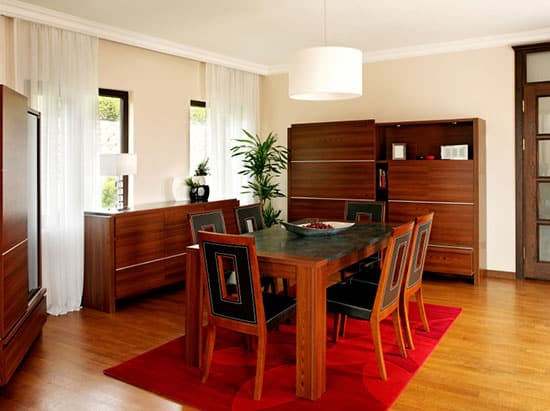
The beauty of cherry wood makes it a great option for furniture, cabinetry, and decorative items.
Cherry wood is a domestic hardwood that’s usually easy to source. Its fine, straight grain pattern gives it a smooth texture and distinctive reddish brown color. And interestingly, “on exposure to ultraviolet light, cherry products with a natural finish will generally darken in colour over time.”7
Cherry woods beauty makes it a great option for furniture, cabinetry, and decorative items.
Walnut
Walnut wood has a rich, dark color and a beautiful swirling pattern.8
According to the Sustainable American Hardwoods guide, it’s “one of the most durable woods even under conditions favourable to decay.”9
And yet, for hardwood, it’s also fairly easy to work with and takes finishes well.
Use it for high-quality furniture, cabinetry, or flooring.
Mahogany
Mahogany is a tropical hardwood that is reddish-brown with a straight grain. Hardwood lumber professional Stephen Ondich calls it the “elite of hardwoods.” WOOD magazine agrees when it says that mahogany is “synonymous with luxury.”10
That also means the price tag is higher. Choose mahogany for fine furniture, cabinetry, decorative items, or other projects that require beautiful wood, like musical instruments.
Pine
Pine is a light-colored wood and one of the most common and least expensive softwoods. It’s lightweight and has a straight grain—both qualities that make it easy to work with.
It makes a great option for indoor projects—furniture, cabinetry, decorations—particularly if you want a rustic or country feel.
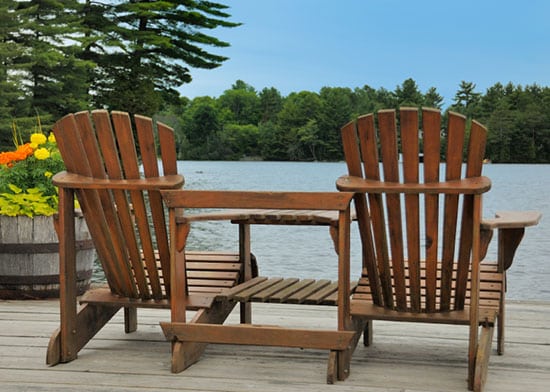
Cedar is resistant to rot and insects, making it a perfect choice for outdoor furniture, decks, and fencing.
Cedar
Cedar wood is best known for its pinkish-red color and its distinctive aroma that comes from the polyoxyphenols in the wood. The red cedar is a popular look.
That aroma makes cedar resistant to rot and insects—and as a result, perfect for outdoor furniture, decks, and fencing. It may not be the best indoors because it can be a skin irritant and an allergen for some people.
One wood that isn’t as common but also great for woodworking is madrone wood. Read our article to discover the allure of its rich mocha brown tones, the elegance of its smooth grain, and the timeless appeal of its ever-changing hues.
Best Wood to Use by Projects
You may be wondering what wood is best for a specific project. We’ll look at three categories: flooring, cabinets, and furniture.
For each one, you’ll want to consider the following factors:
- Durability: How strong does the wood need to be to hold up to its intended use?
- Appearance: Is this simply a functional piece, or will it serve as an important piece of decor? Will it be finished, painted over, or stained?
- Workability: How easy is it to work with?
- Cost: How much are you willing to spend?
Best Wood for Flooring
For flooring, you’ll want to choose wood that’s very durable, hard, and resistant to scratches and dents. Hardwoods are generally a better option than softwoods.
Beauty is another important factor since flooring allows you to show off distinctive grain patterns.
Some great hardwood options are:
- Oak
- Maple
- Hickory
- Brazilian cherry
Best Wood for Cabinets
Durability is important for cabinets, though not as much as with flooring. Here, you have a little more flexibility.
Many cabinetmakers use plywood for the structural components of the cabinet and only solid wood on the external parts. The most common species are cherry, maple, oak, hickory, and birch.
Cherry may very well take the cake as one of “North America’s finest cabinet woods” according to the Encyclopedia of Wood.11 Woodworker and author Terry Porter also calls it a “prized cabinetmaking wood.”12
Best Wood for Furniture
Hardwoods are preferable for furniture, especially if you want a more distinct, attractive appearance and need something durable.
Oak and maple are both great for very sturdy furniture, like chairs, tables, bed frames, and dressers. Cherry is an elegant option for dining tables and dressers.
For high-end furniture, such as desks, bookcases, dining tables, or beds, walnut and mahogany are excellent choices.
Cuban mahogany was used by furniture makers in England to make luxury pieces. Because of its tight grain, it takes finishes well. Unfortunately, Cuban mahogany almost went extinct and is quite scarce today, so woodworkers opt for alternatives like Honduran mahogany or varieties from Africa.13
On a forum discussing the best wood for furniture, a former cabinet builder and manager for Architectural Millwork suggested Honduran mahogany and red oak. But he put in a word for softwoods too:
“People tend to overlook the softwoods these days, but they are VERY easy to work, inexpensive and quite handsome. Alaskan Yellow Cedar is a lovely wood, as is Douglas fir. Good straight grained hard white pine makes fine furniture, and the slightly softer nature of the wood, makes it easier for beginners to work with.”
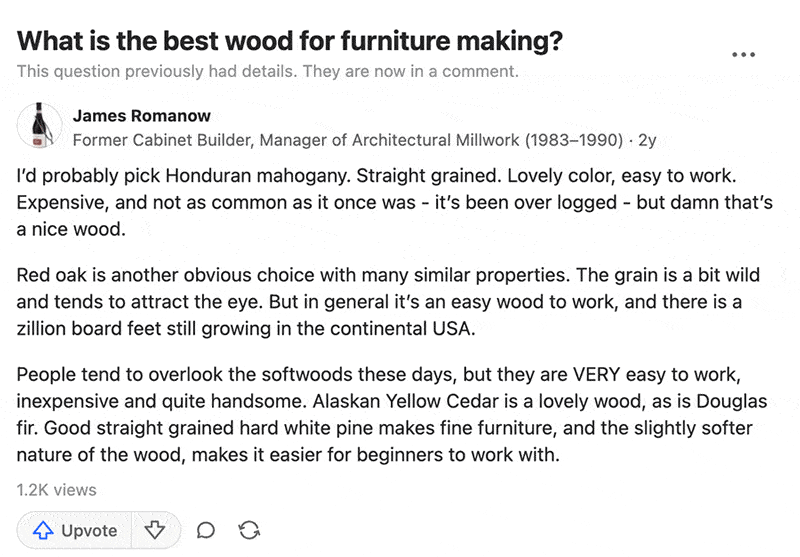
Now that you have a better idea of your wood options, take a look at the following pointers for making the purchase.
Tips on Buying Wood
As you source and buy your wood, here are a few guidelines to help you in the process:
1. Determine your project requirements
Ask yourself the following questions:
- What will be the size of my project?
- What will be its function?
- Will it be located indoors or outdoors?
Many of your other decisions will depend on how you answer these questions.
For example, if you’re building a bench for your backyard, you’d choose a wood that is more resistant to insects and decay than if you were building a shelf for your bedroom.
2. Choose the right species
Use the above information about various wood species to make a decision based on your requirements, budget, and desired appearance.
Also, keep in mind that different species of wood have different “textures”—referring to how porous the wood is. Wood with larger cells will have a rougher texture and may need a wood filler to get a smoother finish. You can choose wood from three different texture categories:14
- Fine grain (e.g., maple, sycamore)
- Medium grain (e.g., walnut, mahogany)
- Coarse grain (e.g., oak, ash)
And regardless of the texture, wood with a straight grain will be more stable, stronger, and easier to work with.
An article in WOOD magazine provides the following reasons for choosing wood with a straight grain:
“In structural applications, such as home construction, lumber (mostly softwood) with other than straight grain loses some strength. And hardwood boards without straight grain require extra care in machining to avoid tearout and other reactions.”15
3. Consider sustainability
Sustainable wood comes from responsibly managed forests that focus on preventing deforestation, soil degradation, and loss of forest biodiversity.16 Look for FSC-certified wood. Woodsearch is an online database that can help you find it in your area.
Another sustainable option is using reclaimed wood (such as from old buildings or barns).
By choosing wood from a sustainable source, you can help conserve natural resources and reduce waste.
4. Consider quality
Quality is determined not only by the type of species you choose but also by the grade of the wood. Grading is based on the characteristics and defects of a wood board.
Hardwoods are graded according to the guidelines of the National Hardwood Lumber Association (NHLA), based on “size and number of cuttings (pieces) that can be obtained from a board.”17
The NHLA’s guide says these rules were “designed with the furniture trade in mind to provide a measurable percentage of clear, defect-free wood for each grade. The upper grades provide the user with long clear pieces, while the Common grades are designed to be re-sawn into shorter clear pieces.”18
The grades, in order, are:
- FAS (Firsts and Seconds)
- F1F (FAS One Face)
- Select
- No. 1C (Number 1 Common)
- No. 2AC (Number 2A Common)
- No. 2BC (Number 2B Common)
Typically, FAS is recommended for high-quality furniture, but many lower grades can provide smaller amounts of defect-free wood.
WOOD magazine explains why:
“Because the rules consider yield rather than aesthetics, a board cut from a lower grade, though often smaller, may look every bit as good as a board from the top grades.”19
So choose your hardwood grade based on the size of boards you need. You’ll find that N1C is suitable for many woodworking projects.
5. Consider the grain structure
The grain structure of the wood helps determine its stability.
Woodworker Joshua Farnsworth, in a video with tips on how to choose lumber for woodworking, says that this is one of the points he considers.
He mentions three main grain structures to be aware of:
- Flatsawn—an end grain that is curved
- Quartersawn—a vertical end grain
- Riftsawn—an end grain that’s at an angle
When building furniture, he typically chooses quartersawn wood because it’s much less likely to warp than flatsawn wood. He brings a block saw with him to uncover the end grain of the wood if it’s not visible.
6. Check for defects
Before purchasing your wood, inspect it carefully. Look for knots, wormholes, cracking, splitting, or warping.
Warping indicates a moisture problem and may lead to more significant issues later on. That’s why we also recommend the next step when purchasing wood.
7. Measure the wood’s moisture content
As a material that absorbs and releases moisture, wood can expand and shrink based on ambient conditions. This makes it essential to have wood at the proper moisture level and keep it in a stable environment.
But the people selling or delivering the wood to you may not have taken the needed precautions. That leaves the responsibility on you to check the moisture content of the wood before you purchase it. Most professionals have stories where at some point, they forgot to check the wood they were buying, and it ends up causing massive headaches down the line.
By using a professional-grade moisture meter during your buying and building process, you can avoid damage, such as warping, shrinking, or cracking, and other damage to both the project and your reputation.
Simply keep a high-quality pinless moisture meter on hand and use it to scan the wood (we recommend checking every part to avoid trapped pockets of moisture). Check that the wood is at or near the desired final moisture content (equilibrium moisture content or EMC).
The One Factor That Matters Even More than Species
Choosing wood for woodworking projects doesn’t have to be complicated. Many species are suitable across projects, giving you several options.
But the right kind of wood doesn’t guarantee success.
When it comes to the quality of your final project, having a stable piece of wood with the right moisture content makes a much larger difference than the species.
Use an accurate, professional moisture meter to help you confirm moisture content at purchase and before you begin your project. It’ll give you the knowledge to make woodworking decisions with confidence. And to create a piece of woodwork that will last for years to come.
- Terry Conners, “Distinguishing Softwoods from Hardwoods,” Agriculture and Natural Resources Publication, University of Kentucky.
- Ibid.
- “Difference Between Hard and Soft Woods?” Woodworker’s Journal.
- Feldman, Lew, “I’m Glad You Asked: The Story of Hardwood and Softwood,” University of California Botanical Garden at Berkeley.
- Meier, Eric, “Differences Between Hard Maple and Soft Maple,” The Wood Database.
- Ibid.
- Sustainable American Hardwoods, p. 9.
- “Nuts about Walnut,” WOOD, July 18, 2016.
- Sustainable American Hardwoods, p. 21.
- “Mahogany: Wood of Kings,” WOOD, March 28, 2017.
- Walker, Aidan, Encyclopedia of Wood (United Kingdom, Facts on File, 2005), p. 109.
- Porter, Terry, Wood: Identification & Use (Guild of Master Craftsman Publications, East Sussex, 2006), p. 150.
- “Mahogany: Wood of Kings.”
- “Understanding Wood Grain,” WOOD, Nov. 2, 2018.
- Ibid.
- “Using Low-Impact Materials: Sustainable Woods,” American Society of Landscape Architects.
- The Illustrated Guide to American Hardwood Lumber Grades, American Hardwood Export Council, p. 1.
- Ibid.
- “Hardwood Grade School,” WOOD, Feb. 15, 2018.
Jason has 20+ years’ experience in sales and sales management in a spectrum of industries and has successfully launched a variety of products to the market, including the original Rapid RH® concrete moisture tests. He currently works with Wagner Meters as our Rapid RH® product sales manager.
Last updated on March 20th, 2025


